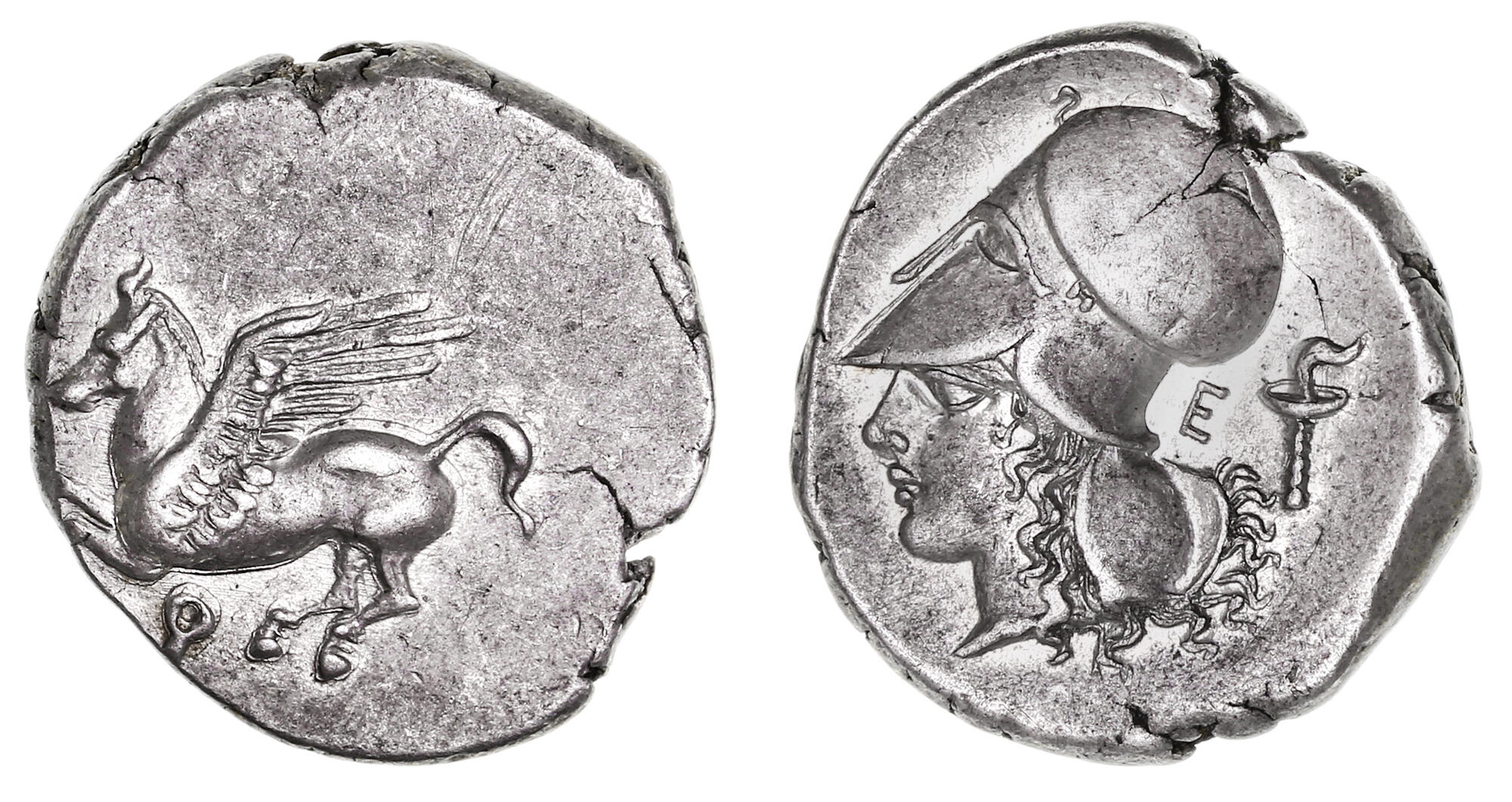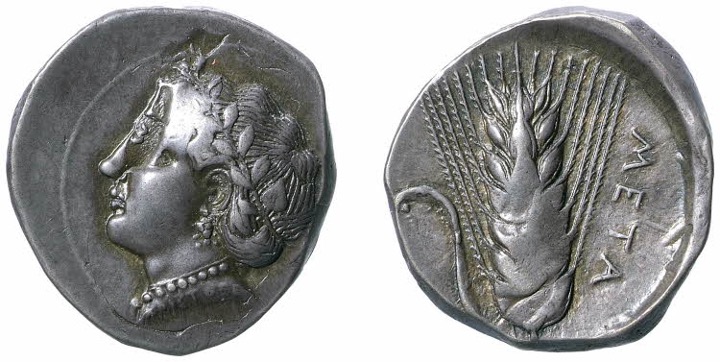1876 - Metapontum (nomos Demeter/ear of barley) over Corinth (Pegasus/Athena) (London, BM, RP Knight, p. 277, A.28)
From SILVER
340 BCE - 330 BCE | META
Images
Overstruck variety

Corinth Calciati 372.jpg [1]
Location/history
| Museum collectionMuseum collection: | London, British Museum, Richard Payne Knight, p. 277, n° A.28. | |
| Private collection(s)Private collection(s) ᵖ: | Richard Payne Knight |
Overstriking coin
Description
| ObverseInscription or printing placed on the obverse.: | Head of Demeter left, with pendant earring and neklace, wearing leaf wreath. On troncation, ΑΡΙΣΤΟΞΕ. | ReverseInscription or printing placed on the reverse.: | META (Greek) Ear of barley with leaf to left. |
Mint and issuing power
| MintIdentifies the place of manufacture or issue of a numismatic object.: | Metapontum | Ancient regionAncient region. | Lucania | Modern countryModern country: Italy | AuthorityIdentifies the issuing power. The authority can be "pretended" when the name or the portrait of X is on the coin but he/she was not the issuing power. It can also be "uncertain" when there is no mention of X on the coin but he/she was the issuing power according to the historical sources: |
Chronology
| FromIdentifies the initial date in a range assigned in a numismatic context. 340 BCE toIdentifies the final date in a range assigned in a numismatic context.. 330 BCE | Classical 480-323 BC |
Physical description
| MetalThe physical material (usually metal) from which an object is made.: Silver |
WeightWeight of the numismatic object (in grams). in grams: 7.877.87 g <br />7,870 mg <br /> | DenominationTerm indicating the value of a numismatic object. Examples: tetradrachm, chalkous, denarius.: nomos | AxisDescribes the directional relationship between the obverse and reverse of a numismatic object.: 66 mm <br />0.6 cm <br /> |
| StandardStandard.: Achaian | |||
References
| Coin referenceReference of the Coin: | Knight 1830, p. 277, n° A28, BMC Italy, p. 247, n° 74, Noe 1957, group IV, p. 26, pl. VIII, n | Coin series referenceReference to coin series study: | Knight 18301Knight 1830, p. 277, n° A28, BMC Italy2BMC Italy, p. 247, n° 74, Noe 19573Noe 1957, group IV, p. 26, pl. VIII, n, HN Italy4HN Italy, n° 1519-1522, HGC 15HGC 1, n° 1045 |
| Coin series web referenceCoin series web references: | |||
Overstruck type
Description
| ObverseInscription or printing placed on the obverse.: | Pegasus flying left | ReverseInscription or printing placed on the reverse.: | ΑΡΙΣΤΟΞΕ (Greek) Head of Athena left, wearing Corinthian helmet. |
Mint and issuing power
| MintIdentifies the place of manufacture or issue of a numismatic object. ᵖ: | Corinth | Ancient regionAncient region. ᵖ | Peloponnesus | Modern countryModern country: Greece | AuthorityIdentifies the authority in whose name (explicitly or implicitly) a numismatic object was issued. ᵖ: |
Chronology
| FromIdentifies the initial date in a range assigned in a numismatic context. 380 BCE toIdentifies the final date in a range assigned in a numismatic context.. 340 BCE | Classical 480-323 BC |
Physical description
| DenominationTerm indicating the value of a numismatic object. Examples: tetradrachm, chalkous, denarius. ᵖ: | stater |
StandardStandard. ᵖ: | Aeginetic |
References
| Coin type referenceReference to coin series study ᵖ: | Calciati 19906Calciati 1990 | ||
| Coin series web reference overstruckCoin series web references overstruck: | |||
Additional data
| Frequency of overstrikesFrequency of overstrikes: | rare and concentrated | Level of confidenceLevel of confidence of the identification: | strong |
| RemarksRemarks: | |||
References
- ^ Knight, Richard Payne (1830), Nummi Veteres Civitatum, Regum, Gentium, et Provinciarum, Londini in Museo Ricardi Payne Knight Asservati, ab ipso Ordine Geographico Descripti, Londini : excudebat Gulielmus Nicol.
- ^ Poole, Reginald Stuart (1873), A Catalogue of the Greek Coins in the British Museum. Italy, London, 2 p. l., viii, 432 p.
- ^ Noe, Sydney P. (1957), "Overstrikes in Magna Graecia", American Numismatic Society. Museum Notes 7, p. 13-42, pl. 5-14.
- ^ Rutter N. Keith et alii (eds.) (2001), Historia Numorum Italy, London, xvi, 223 p., 43 pl.
- ^ Hoover, Oliver D. (2018), The Handbook of Greek Coinage Series, Volume 1. Handbook of Coins of Italy and Magna Graecia, Sixth to First Centuries BC., Lancaster-London, 2018, lxi, 527 pages, 23 cm
- ^ Calciati, Romolo (1990), Pegasi, Mortara, Edizioni I.P..
